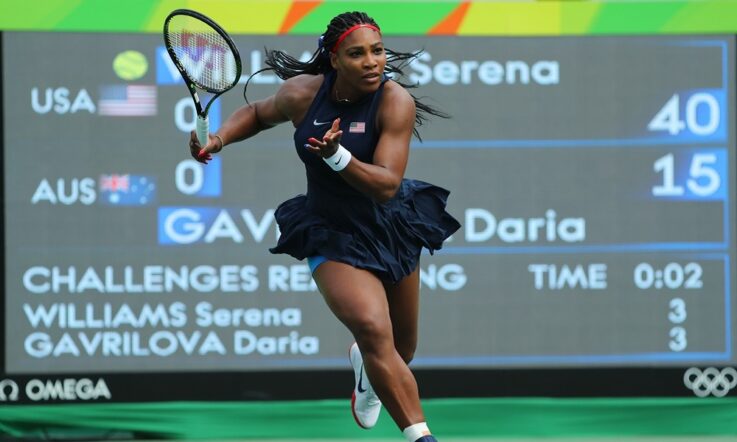In a recent Teacher article, Dave Tout, Justine Sakurai, and Carly Sawatzki discussed numeracy and its relationship with mathematics and the importance of real-world contexts. In this follow-up, they delve deeper into contextualised teaching and learning of mathematics through the exploration of six numeracy contexts, and provide several examples of what this could look like in the classroom.
Mathematics being presented as a series of algorithms to master, devoid of context, explains why some students become alienated from mathematics (Hersh & John-Steiner, 2011). Moreover, schools and teachers have an ethical obligation to teach young people to use and apply mathematics in a range of numeracy contexts (Ernest, 2019).
Students who can see the relevance of what they are learning, and the usefulness and application of these ideas beyond the classroom, are more likely to engage with the mathematical learning process (Downes & Bishop, 2012). Here, we illustrate the possibilities for designing and enacting mathematics curricula in research-informed ways that more meaningfully connect with students’ current and future lives.
Curriculum plus context
As we shared in our previous article, we’ve been working collaboratively to help shape and write Victorian senior secondary curricula that better supports the development of students’ critical numeracy and maths skills. Consistent with successful reforms internationally in countries such as Singapore (Ministry of Education Singapore, 2019) and the Netherlands (Van den Heuvel-Panhuizen & Drijvers, 2020), the approach in Victoria is to encourage contextualised teaching and learning of mathematics, with different numeracy contexts (Gal et al., 2020) specified for exploration.
Contexts and numeracies that are visible in students’ everyday lives include personal decision making (personal numeracy), civics and citizenship (civic numeracy), economics and finance (financial numeracy), exercise and health (health numeracy), workplace applications (vocational numeracy), and entertainment and leisure (recreational numeracy). The proposed numeracy curriculum in Victoria is framed around these six numeracies and guidance is provided for teachers in selecting real life contexts that are realistic and relevant for students.
We believe that the contexts, and hence different numeracies, provide a spark or starting point for teaching and learning, and the curriculum should encourage creativity in enactment at the classroom level. Context creates a reason to develop mathematical knowledge and skills and emergent opportunities for explicit teaching of mathematical concepts. It helps students to identify how and where mathematics might be used and applied, how various calculations and procedures can be used to explain and support real-world problems, decisions, and arguments (Frankenstein, 2009).
Like in the Singapore mathematics curriculum, this is approached using a problem-solving model, which starts with the identification of a context or real-world problem for students to consider (Ministry of Education Singapore, 2019). Real-world contexts derived from different numeracies are explicit in driving the model, from framing the issue, then deciding on and choosing the mathematics to act on. And next, in interpreting and reflecting on the solution and reporting on the outcomes, as elaborated in the problem-solving cycle we described in the first article.
The proposed Victorian curriculum is structured in such a way to allow flexibility and longevity – anticipating that the real-world contexts teachers and students choose to explore will change over time. So while the way the learning outcomes are named and described remains constant, there is room for teachers and students to choose, adapt and investigate problems and issues that matter to them, in their setting, at that point in time. The curriculum is designed flexibly and is adaptable in that the teacher can select the most relevant and appropriate mathematical content that supports each particular numeracy and its context and the problem(s) being investigated.
Here are a several examples of what this approach could look like in your classroom for two of the six numeracy contexts.
Classroom examples for developing civic numeracy
Civic numeracy is critical for effective participation in society and prepares young people to both understand the crucial issues which define our lives (Weiland, 2017), and to participate in democratic and informed ways (Education Council, 2019).
A challenge that the next generation confronts is global warming due to human influence. Young people’s activism via School Strike 4 Climate rallies indicates the potential for this important context to spark meaningful teaching and learning of mathematics (Ariza et al., 2021). There are clear problems to address with various foci that might frame a unit of work – for example, conducting an audit of waste to landfill, or planning a social enterprise simulating a circular economy. The mathematics to be taught and learned is largely determined by the context, but the learning that eventuates will be transferable to a range of other contexts.
The COVID-19 pandemic has made mathematics more visible in our daily lives, highlighting to professional educators the importance of critical statistical literacy to make sense of reports and claims made via media and social media. Explanations by politicians, health experts and journalists regarding the number and spread of cases, vaccination rates and exposure sites have varied from state to state, leading the public to question the trustworthiness of public figures and the information they rely on.
Another valuable skill required to navigate the chaos of living with COVID-19 is the ability to read and interpret exposure maps. This relies on understanding time and space, including maps and locations. Those who are proficient in understanding concepts of north, south, east, and west, can manipulate digital maps, scrolling and sliding to find the locations that may correlate with their own movements on various dates and times. It also requires an ability to estimate what time they were in a location – does it match the exposure site window? Similar map reading skills are required during bushfire season.
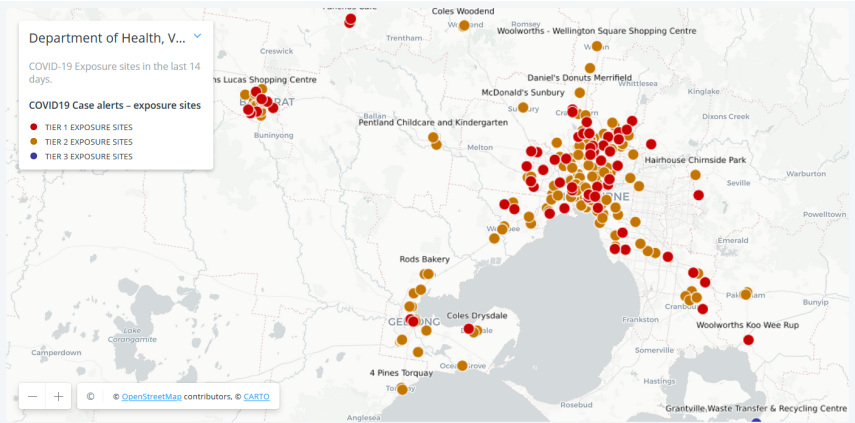
[Screenshot of public exposure sites from
https://www.coronavirus.vic.gov.au/case-alerts-public-exposure-sites, accessed September, 2021]
Civic numeracy extends to tuning students into social justice issues. For example, an investigation comparing the cost of a fixed basket of grocery items across different locations may lead students to discover disparities in costs of living. The approach itself models that used by the Australian Bureau of Statistics to measure the consumer price index (inflation).
The question of social inequality could be extended to an exploration of gender. The COVID-19 pandemic is widening the gender pay and superannuation gap, with recent reports revealing women are more likely than men to reduce their working hours to support their children’s remote learning (Irvine, 2021). And, recent media coverage highlighted figures from the Workplace Gender Equality Agency showing ‘in the past six months, the gender pay gap has widened to 14.2 per cent’ (Kelly, 2021).
The mathematical knowledge and skills developed through these contexts would be transferable to an investigation of government decision-making. A topical example is the allocation of funding for community sports infrastructure. Students might research publicly available information and create a spreadsheet of data, making decisions how to present and analyse such information as suburb, electorate, amount and for what purpose the funding was granted.
Studying issues such as the examples given above gives students agency in the learning process, and the problem-solving skills to make sense of their world, including how power and information are used. Understanding these sorts of issues prepares students for active citizenship where, through their decisions and behaviour, they can contribute to positive social change.
Classroom examples for developing vocational numeracy
The proposed curriculum incorporates a focus on vocational numeracy, without limiting the possibilities for what students’ vocational pathways might be or what the current or future use of mathematics in those settings might be. Again, the aim is flexibility and longevity.
The research on numeracy and maths in the workplace consistently shows that school leavers are not ready for the world of work, perhaps due to the significant disconnect between maths in the school classroom and maths at work (for example, see AAMT & AiGroup 2014; Gravemeijer et al., 2017; Shomos, 2014). Increasingly this relates to the knowledge, familiarity and use of technology at work (Hoyles et al., 2010). The AAMT and AiGroup research (2014) stated:
Many people in the workplace are engaged with technology, particularly in using spreadsheets and graphical outputs. There is an inter-dependency of mathematical skills and the use of technology in the workplace in ways that are not commonly reflected in current teaching practice. (p. 2)
Hoyles and colleagues (2010) named the most relevant workplace maths topics as including measurement, data collection, variables and co-variation, reading and interpreting data, graphs, and charts. The AAMT and AiGroup research (2014) described a range of similar skills and also named estimation, interpreting plans, diagrams and scale drawings, the use of formulae and number skills and undertaking calculations.
So for the senior years of schooling, it is becoming more critical to address the world of work and vocational learning. But how do you do this in a school setting, where students have diverse vocational aspirations and interests? Relatively common examples that cover a good range of maths skills can be readily found in interior design and decoration; building and construction; retail and visual merchandising; hospitality; agriculture, horticulture and landscaping; and sports and recreation. However, a broader range can be found if you make connections with local or regional businesses or industry. Approach them and ask if you can organise an incursion or excursion to talk about what maths related tasks are undertaken within their workplaces. Or if students are studying a VET (Vocational Education and Training) subject, get them to research, investigate and document what maths is required within that vocation.
For example, a kitchen design company may be prepared to share with students the process of working from their initial rough sketches made in the home through to the production of their final plans for a kitchen renovation, including demonstrating what CAD (computer-aided design) applications are used. This process can then be imitated in the classroom, based on photos and sketches of some students’ own kitchens that students feel need renovating.
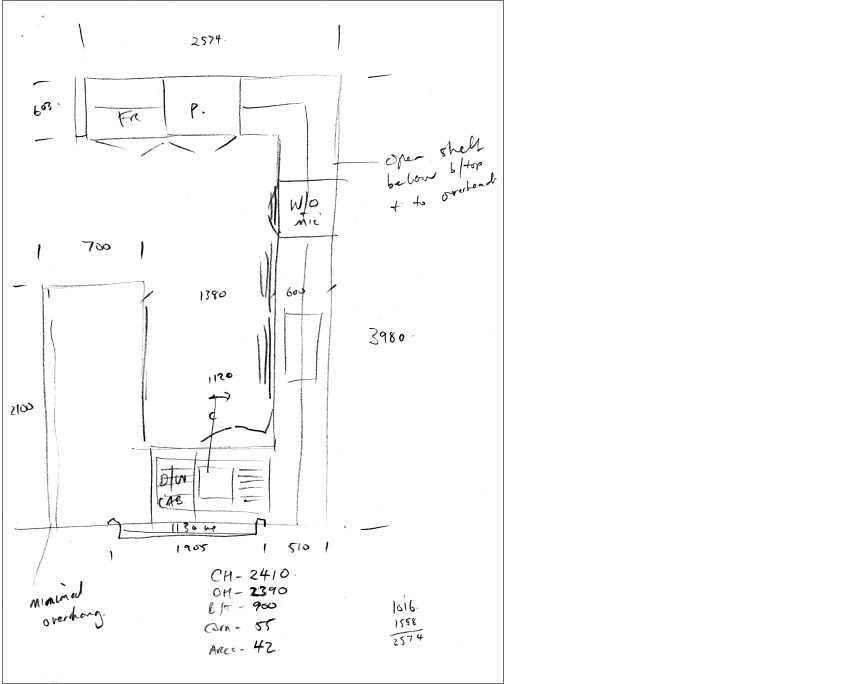
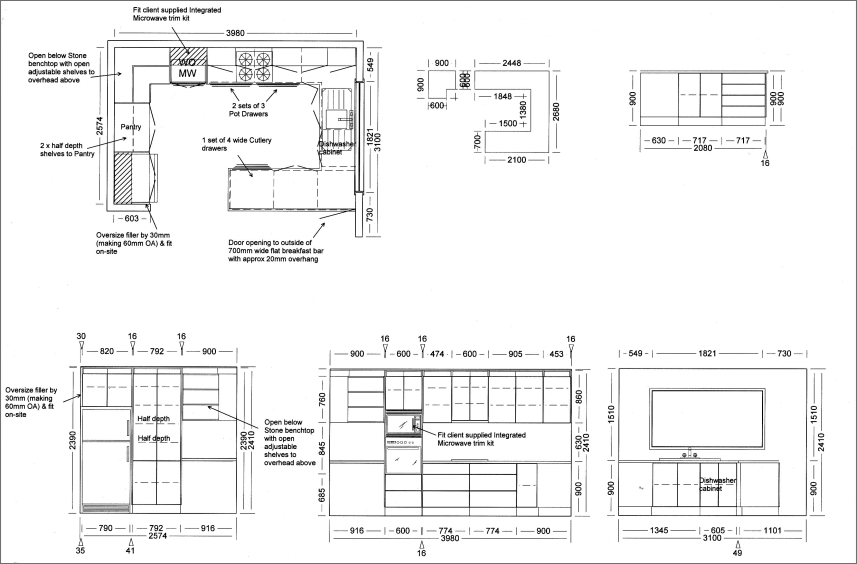
A local business might be prepared to share how they use spreadsheets at work. It might be for keeping track of their stock levels and record keeping, for staffing, OH&S (Occupational Health and Safety) incidents, or for their budgeting. They could demonstrate how they use formulae in the spreadsheets, and students could be given mock data and information to manipulate.
Measurements, proportions and ratios are commonly used in a range of settings, from hairdressing to catering to agriculture. Businesses may well be prepared to share their specifications or standard operating procedures for their processes. For example, chemicals are mixed when hairdressers blend colour and when farmers make decisions about seed sowing, fertilising and using pesticide sprays. Caterers adjust food orders and recipes to accommodate different size functions. Ask workplaces about accuracy and tolerances, and the impact of miscalculations in terms of costs and waste associated with production. What machinery or technologies do they use to control, manage and optimise the production process? Based on the information you and students are able to gather, you may be able to highlight what maths skills are required and get students to analyse and simulate these processes themselves.
Here is an example of a standard operating procedure from food processing about making commercial sliced roast beef that highlights the range of measurement knowledge and skills required.
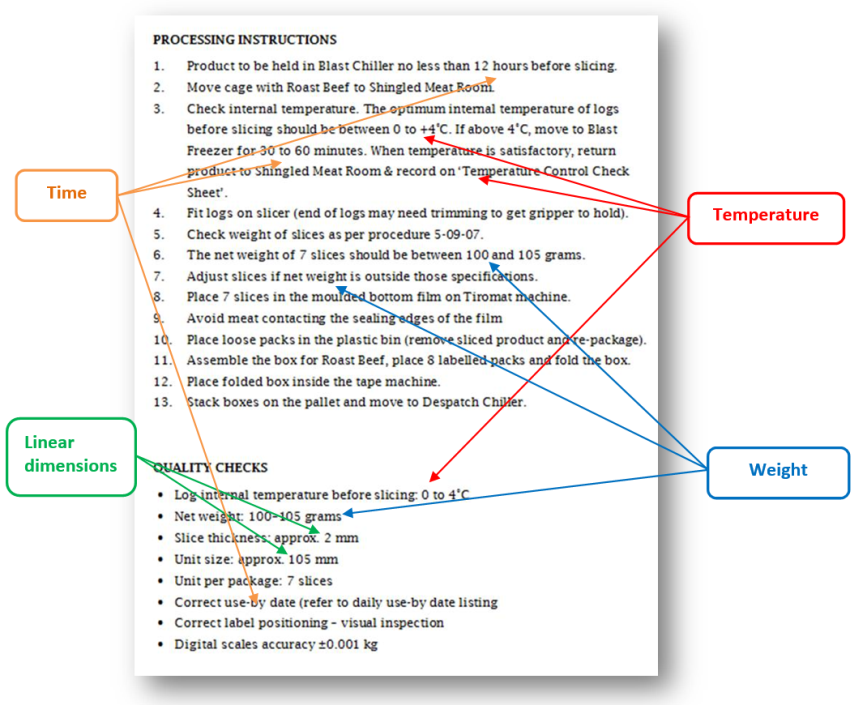
Concluding remarks
Schools and teachers are ultimately responsible for enacting the curriculum. Teachers’ professional agency and student voice are firmly anchored in the way curriculum is implemented locally (Kirk & MacDonald, 2001).
Our strong recommendation is to get creative and put real life contexts front and centre of your lessons, making mathematics relevant, engaging and meaningful – this is the best way to deliver improved learning opportunities and outcomes for students.
References
Australian Association of Mathematics Teachers (AAMT) & Australian Industry Group (AiGroup). (2014). Tackling the School–Industry Mathematics Divide. Commonwealth of Australia. https://www.chiefscientist.gov.au/sites/default/files/Quantitative-Skills-of-21st-Century-Workers-Summary.pdf (PDF, 355KB)
Ariza, M. R., Armenteros, A. Q., & Castro, A. E. (2021). Promoting critical thinking through mathematics and science teacher education: the case of argumentation and graphs interpretation about climate change. European Journal of Teacher Education, 1-19. https://doi.org/10.1080/02619768.2021.1961736
Downes, J. M., & Bishop, P. (2012). Educators engage digital natives and learn from their experiences with technology: Integrating technology engages students in their learning. Middle School Journal, 43(5), 6-15. https://doi.org/10.1080/00940771.2012.11461824
Education Council. (2019). The Alice Springs (Mparntwe) Education Declaration. https://www.dese.gov.au/alice-springs-mparntwe-education-declaration/resources/alice-springs-mparntwe-education-declaration
Ernest, P. (2019). The Ethical Obligations of the Mathematics Teacher. Journal of Pedagogical Research, 3(1), 80-91. https://eric.ed.gov/?id=EJ1292...
Frankenstein, M. (2009). Developing a critical mathematical numeracy through real real-life word problems. In L. Verschaffel, B. Greer, W. Van Dooren, & S. Mukhopadhyay (Eds.), Words and worlds (Vol. 16, pp. 111-130). Brill Sense. https://doi.org/10.1163/9789087909383_008
Gal, I., Grotlüschen, A., Tout, D., & Kaiser, G. (2020). Numeracy, adult education, and vulnerable adults: a critical view of a neglected field. ZDM Mathematics Education, 52(3), 377-394. https://doi.org/10.1007/s11858-020-01155-9
Gravemeijer, K., Stephan, M., Julie, C., Lin, F. L., & Ohtani, M. (2017). What mathematics education may prepare students for the society of the future? International Journal of Science and Mathematics Education, 15(1), 105-123. https://doi.org/10.1007/s10763-017-9814-6
Hersh, R., & John-Steiner, V. (2011). Loving + hating mathematics : challenging the myths of mathematical life. Princeton University Press.
Hoyles, C., Noss, R., Kent, P., & Bakker, A. (2010). Improving Mathematics at Work: The Need for Techno-Mathematical Literacies. Routledge.
Irvine, J., (2021, September 7). Women accept secondary income earner role at their financial peril. Sydney Morning Herald. https://www.smh.com.au/business/workplace/women-accept-secondary-income-earner-role-at-their-financial-peril-20210906-p58p3x.html
Kelly, F. (2021, August 31). The better paid sex: Australia's gender pay gap widens. RN Breakfast. https://www.abc.net.au/radiona...
Kirk, D., & MacDonald, D. (2001). Teacher voice and ownership of curriculum change. Journal of curriculum studies, 33(5), 551-567.
Ministry of Education Singapore. (2019). Mathematics Syllabus. Curriculum Planning and Development Division. https://www.moe.gov.sg/secondary/courses
Shomos, A., & Forbes, M. (2014). Literacy and numeracy skills and labour market outcomes in Australia. Productivity Commission Staff Working Paper. Australian Government. http://hdl.voced.edu.au/10707/308789
Van den Heuvel-Panhuizen M., & Drijvers P. (2020) Realistic Mathematics Education. In S. Lerman (Ed.), Encyclopedia of Mathematics Education. Springer, Cham. https://doi.org/10.1007/978-3-...
Weiland, T. (2017). Problematizing statistical literacy: An intersection of critical and statistical literacies. Educational Studies in Mathematics, 96(1), 33-47. https://doi.org/10.1007/s10649-017-9764-5
With a colleague, consider a problem-based task you’ve used in one of your own lessons. Was this problem real, relatable and relevant to your students, their context and experiences?
With a colleague, look at the examples given by the authors in this article. How could you introduce one of these tasks into your own lessons? What supporting resources will you need? For example, health maps or information from local businesses.


